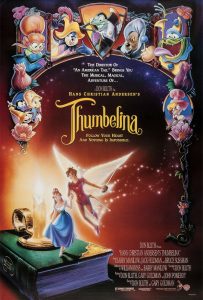 Thumbelina is based on a timeless story, but the movie is a product of its time.
Thumbelina is based on a timeless story, but the movie is a product of its time.
Celebrating its 30th anniversary this year, the film was released to theaters amid the animation renaissance of the ’90s, several years after Disney’s Beauty and the Beast and Aladdin and just three months before The Lion King would achieve landmark blockbuster status.
Like numerous “non-Disney” animated films at the time, Thumbelina is one of many not released by the ol’ Mouse House that looked to replicate the Disney paradigm in form, in feeling, in every way.
This is ironic in that the film was co-directed by Don Bluth and Gary Goldman. The two were part of a much-discussed walk-out of animators from the Disney studio in 1979 and went on to direct such 80s animated hits as An American Tail (1986) and The Land Before Time (1988). When Thumbelina was released, critic Roger Ebert noted, “Bluth originally left Disney because he found the studio’s animation efforts moribund. The irony is that his own films now more closely resemble the Disney of the 1970s than those from the current studio.”
Ebert was one of the many who didn’t care for Thumbelina, but there is a solid, nostalgic connection for those who grew up with the film, particularly on subsequent VHS viewings. Just scan through the glowing user reviews on IMDb, and it’s clear that Bluth’s audience for Thumbelina has stayed faithful to the film over the past three decades.
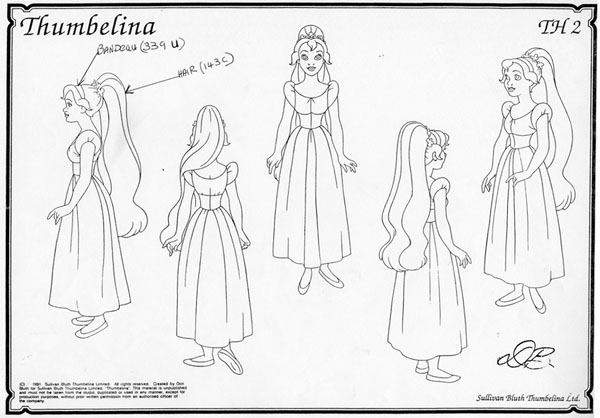
Opening on a lovely shot of Paris, the film, based on the famous story by Hans Christian Andersen, is narrated by a swallow named Jacquimo, who tells us the tale of a lonely widow who longs to have a child.
Seeking guidance from a witch, she is given a seed that, when planted, blooms into a flower, and inside is a tiny girl that the widow names Thumbelina. The woman raises Thumbelina, but the tiny girl yearns to meet someone her own size.
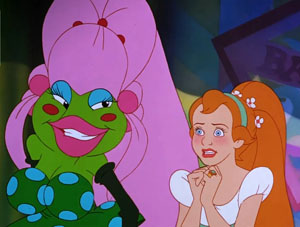 Late one night, Thumbelina meets Cornelius, the fairy prince, who is the same size as her. They are so enchanted with each other that Thumbelina flies off with Cornelius on his bumble bee.
Late one night, Thumbelina meets Cornelius, the fairy prince, who is the same size as her. They are so enchanted with each other that Thumbelina flies off with Cornelius on his bumble bee.
While out in the world, Thumbelina has a number of adventures as she attempts to find her way back home. Cornelius tries to find her, she is kidnapped by Mrs. Toad and her son Grundel, and Mrs. Toad looks to arrange a marriage between Thumbelina and her son. Thumbelina meets the slick Berkeley Beetle, who promises to help her get home, but first, she must accompany him to the Beetle Ball; Thumbelina takes refuge in the home of Miss Fieldmouse and winds up forced to marry Mr. Mole, but course, Cornelius eventually finds his way to Thumbelina and, spoiler alert, they live happily ever after.
Bluth and Goldman employ lush animation and character design in Thumbelina that does indeed harken back to previous Disney films, as well as Richard Williams’ Raggedy Ann and Andy, and a little of the Fleischer Bros. There’s quite a bit of rotoscoping used to bring Thumbelina and Cornelius to the screen, but the more anthropomorphized players are brought to the life with pleasant character design.
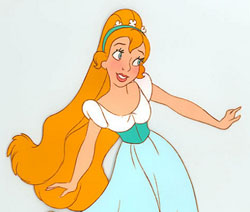 One only wishes that this artistry was partnered with a stronger story that allowed for some emotional attachment to the characters. Thumbelina’s songs are from Barry Manilow and William Ross, two tremendous talents who deliver serviceable and some humorous songs, most notably, the campy “Marry the Mole,” sung by none other than Carol Channing as Mrs. Fieldmouse.
One only wishes that this artistry was partnered with a stronger story that allowed for some emotional attachment to the characters. Thumbelina’s songs are from Barry Manilow and William Ross, two tremendous talents who deliver serviceable and some humorous songs, most notably, the campy “Marry the Mole,” sung by none other than Carol Channing as Mrs. Fieldmouse.
The rest of the voice cast in Thumbelina includes Gary Imhoff as Cornelius, Gino Conforti as Jacquimo, John Hurt as Mr. Mole, Charo as Mrs. Toad, Kenneth Mars as King Colbert of the Fairies, and voice acting legend June Foray as Queen Tabitha.
Two other members of the cast were closely associated with Disney: The Little Mermaid’s Ariel herself, Jodi Benson is Thumbelina, and Berkeley Beetle is voiced by Gilbert Gottfried, who had voiced Iago, the villainous sidekick parrot in Aladdin (1992).
The Disney influence on Thumbelina carried over even to the film’s early promotion. In Jerry Beck’s book, The Animated Movie Guide contributor W.R. Miller wrote: “According to John Horn in the Los Angeles Times, June 1, 1997, Warner Bros. held two test screenings. In the first screening, the audience reaction was flat. In the second screening, Warner Brothers. prefaced the film with the Disney logo. The audience’s response was more favorable.”
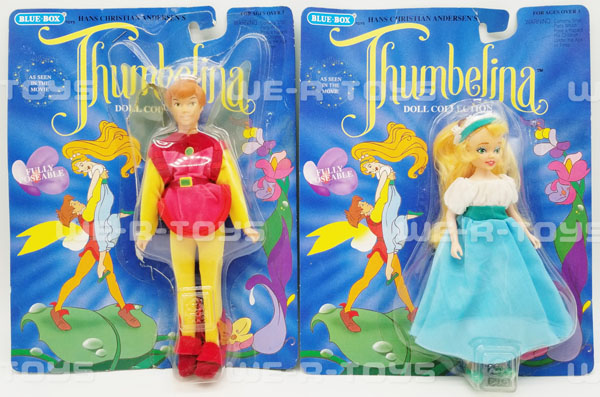
Thumbelina dolls
Unfortunately, such tactics didn’t work, and Thumbelina fared poorly at the box office. Also, the kitschy “Marry the Mole” garnered a dubious Razzie Award for Worst Original Song.
Not long after the film’s release on March 30, 1994, 20th Century Fox announced their new animation studio to be headed by Bluth and Goldman, and the first film would be Anastasia, which would be a significant contender to Disney’s dominance during the decade.
“Competition is always a good thing,” said Bluth in a 1997 interview. “Every person is important; every person has some little bit of truth that everybody should see and hear. When all these artists get together under the umbrella of a studio and decide to make a picture, I think that they’re going to make something that’s noteworthy. Now, whether it’s commercial, by that yardstick meaning that it will make money, you don’t know. But I think competition is wonderful because it keeps us all looking over our shoulders, slightly, to see how good a job we can really do.”


 Michael Lyons is a freelance writer, specializing in film, television, and pop culture. He is the author of the book, Drawn to Greatness: Disney’s Animation Renaissance, which chronicles the amazing growth at the Disney animation studio in the 1990s. In addition to Animation Scoop and Cartoon Research, he has contributed to Remind Magazine, Cinefantastique, Animation World Network and Disney Magazine. He also writes a blog, Screen Saver: A Retro Review of TV Shows and Movies of Yesteryear and his interviews with a number of animation legends have been featured in several volumes of the books, Walt’s People. You can visit Michael’s web site Words From Lyons at:
Michael Lyons is a freelance writer, specializing in film, television, and pop culture. He is the author of the book, Drawn to Greatness: Disney’s Animation Renaissance, which chronicles the amazing growth at the Disney animation studio in the 1990s. In addition to Animation Scoop and Cartoon Research, he has contributed to Remind Magazine, Cinefantastique, Animation World Network and Disney Magazine. He also writes a blog, Screen Saver: A Retro Review of TV Shows and Movies of Yesteryear and his interviews with a number of animation legends have been featured in several volumes of the books, Walt’s People. You can visit Michael’s web site Words From Lyons at: 






















The fact that Warner Brothers would display the Disney logo before a film of their own, this illustrates a horrible flaw of the general public.
Yes, there are far too many that believe anything animated came from Walt Disney. I’ve actually had people tell me, when I’m discussing Bugs Bunny,“that Walt Disney, isn’t he amazing? He’s so versatile!“ So this person actually believe that Bugs Bunny came from Walt Disney! I personally think that the Warner Bros. animators were constantly plagued with the fact that anything they do will be compared to whatever Walt Disney is doing at the moment.
Instead of looking at animation as an art form, just as music as an art form and many different musicians have different styles that are all their own, even if they are showing an influence from another musician, and hopefully this could change over time with all the history out there of all the major animation studios I was not fortunate enough to have actually seen the movie mentioned here, but I just wanted to mention that I understand the feeling of failure when this film did not even make any waves at the box office. I have not heard the songs involved as well.
I don’t know; maybe I would’ve felt the same way, because I am so out of the realm of Walt Disney, but I definitely respect what he’s done with animation. However, we are talking about a time and animation history here where Walt Disney was not necessarily the biggest and the best. People had begun to respect the styles of other animators, and I’m glad of that.
I’ve had conversations in the past like that, where people would rope other iconic characters under the Disney umbrella. I think some of it has to do with public perception. In essence, Walt Disney paved the way for animation and became the most recognizable name in animation, even if he didn’t innovate on every facet of the art form. Even so, I felt like in the 90s, some of that influence still quite stole the thunder from other animation studios. I remember when Don Bluth’s other film Anastasia debuted, there were a lot of folks who assumed it was Disney. For people who are huge animation fans, it becomes easier to identify each animation studio’s style both in art and storytelling similar to understanding differences in painting styles from artists in the 19th century or earlier.
The Disney logo story always fascinates me, partially because it seems so perfectly “urban legend”-y. Still, if it did happen, I wonder if Disney releasing it back then would’ve even changed anything. The year after Thumbelina was when Disney’s winning streak would’ve started to show a little weakening, Toy Story aside. The irony is that Disney owns the film now, since Warner Bros. just… sold it to Fox at some point. Wikipedia says 2002; with a source, it also says that the film was even shown to Buena Vista during Bluth’s bankruptcy. Here’s said source, with its crazy story of Chuck Jones attempting to woo the animators away from the film.
Anyway, you can tell times have changed, since we least have more household names to point to than just Disney or even Pixar. I think those will always be there, no matter how many box office flops (I’m not here to fling shit at Strange World or Wish, I will fully acknowledge my generation has re-appraised films from the 00s the studio took a bath on). Still, it’s crazy how you can say that Universal, who weren’t even in the runnings not so long ago, are a formidable force in the animation field. We even live in a time where anime films can have some relative success and aren’t limited specialty releases one has to travel for. Meanwhile, there aren’t too many box office success stories from the 90s animated field that weren’t wrought from Disney. Yeah, I’d say Thumbelina and the manner it was received was certainly a product of its time.
“Thumbelina” is an odd little movie whose components don’t quite come together: Disney heroine and prince, tacky Bluth animals and “sparkle” effects, Fleischer insects, bad CGI backgrounds (fortunately only a couple). But I like it, particularly the song “Let Me Be Your Wings,” because I know I’d have gone nuts for the movie if I’d been 6 years old; what that says about me or it is open to interpretation. It was a mistake releasing it theatrically prefaced with an “Animaniacs” short (“I’m Mad”) because, even though that was one of the more child-geared “Animaniacs” segments, much of that show’s humor was more sophisticated and cynical than Bluth product.
“Thumbelina” was also a reunion for Barbara Cook and Gino Conforti, who were in the great 1963 Broadway musical “She Loves Me.”
That was a typo, and a “gremlin” (as Jim Korkis called it) that “snuck through.” I had originally written that the film “hadn’t fared well,” then replaced that with “poorly.” In copy and paste haste, the word “well” was never removed.
It’s now fixed, thanks to you. I like Kaufman’s definition. I should have left it and played both sides of the fence. 🙂
Thanks again.
And to think there was Patty Duke as the great Rankin/Bass 60s version in THE DAYDEAMER which also had her TV brother Paul O’Keefe (no other credits to show of, to me), as the star, with HAYLEY MILLS as THE LITTLE MERMAID (caps intended)–and Jodi Benson played BOTH those RB-adapted character more than twentyy yearsm later!
There was an unrelated 2002 Hyperion feature, “The Adventures of Tom Thumb and Thumbelina”, that crossed two fairy tales together. It was released to video by Buena Vista, and likely caused some confusion among video and cable viewers.
In “The Daydreamer” (Rankin-Bass, 1966), the Animagic stories includes Thumbelina with voices by Patty Duke, Boris Karloff and Sessue Hayakawa.
Thumbelina also takes up much of the running time of “Santa Claus and the Ice Cream Bunny”, a live action cheapie best enjoyed in the RiffTrax edition.
Strangely enough, I believe THUMBELINA was only in the beginning “concept” stages when a few “talent scouts” from the Sullivan-Bluth Studio were looking for animators and artists in Chicago (I was a member of ASIFA-Central back then) that would be willing to go to Ireland to work on the production. I was tempted to go. I only had several night classes at Columbia College (in Chicago) “under my belt,” but I thought I could get in “the ground floor” of the project. I decided that I wasn’t ready to take that BIG of a chance and try out. I still wonder if that was the right decsion, or not.
I think Thumbelina is a decent enough film. Although I don’t consider it Don Bluth’s worst film, there were so many missed opportunities that could have made the film great. There are many YouTubers who would be cynical about its imperfections, which I’m not going to mention names, but I think a few reviewers come to mind. However, I wouldn’t put on my nostalgia goggles either, taking into account Thumbelina came out at a time when Don Bluth’s creative ideas were becoming more of a mixed bag of inconsistencies in storytelling and style. My aunt and I still enjoy it for what it is.